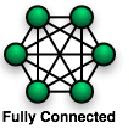A local area network (LAN) is one example of a network that exhibits both a physical and a logical topology. Any given node in the LAN will have one or more links to one or more other nodes in the network and the mapping of these links and nodes onto a graph results in a geometrical shape that determines the physical topology of the network. Likewise, the mapping of the flow of data between the nodes in the network determines the logical topology of the network. It is important to note that the physical and logical topologies might be identical in any particular network but they also may be different.
Any particular network topology is determined only by the graphical mapping of the configuration of physical and/or logical connections between nodes - Network Topology is, therefore, technically a part of graph theory. Distances between nodes, physical interconnections, transmission rates, and/or signal types may differ in two networks and yet their topologies may be identical[2

A mesh network is a local area network (LAN) that employs one of two connection arrangements, full mesh topology or partial mesh topology. In the full mesh topology, each node (workstation or other device) is connected directly to each of the others. In the partial mesh topology, some nodes are connected to all the others, but some of the nodes are connected only to those other nodes with which they exchange the most data.
The illustration shows a full mesh network with five nodes. Each node is shown as a sphere, and connections are shown as straight lines. The connections can be wired or wireless.
STAR TOPOLOGY

Star networks are one of the most common computer network topologies. In its simplest form, a star network consists of one central switch, hub or computer which acts as a conduit to transmit messages. If the central node is passive, the originating node must be able to tolerate the reception of an echo of its own transmission, delayed by the two-way transmission time (i.e. to and from the central node) plus any delay generated in the central node. An active star network has an active central node that usually has the means to prevent echo-related problems.
The star topology reduces the chance of network failure by connecting all of the systems to a central node. When applied to a bus-based network, this central hub rebroadcasts all transmissions received from any peripheral node to all peripheral nodes on the network, sometimes including the originating node. All peripheral nodes may thus communicate with all others by transmitting to, and receiving from, the central node only. The failure of a transmission line linking any peripheral node to the central node will result in the isolation of that peripheral node from all others, but the rest of the systems will be unaffected
FULLY CONNECTED TOPOLOGY
A fully conn
and so it is extremely impractical for large networks. A two-node network, one of the most common network types, is technically a fully connected network.
LINE TOPOLOGY

A line can be described as an infinitely thin, infinitely long, perfectly straight curve (the term curve in mathematics includes "straight curves") containing an infinite number of points. In Euclidean geometry, exactly one line can be found that passes through any two points. The line provides the shortest connection between the points.
In two dimensions, two different lines can either be parallel, meaning they never meet, or may intersect at one and only one point. In three or more dimensions, lines may also be skew, meaning they don't meet, but also don't define a plane. Two distinct planes intersect in at most one line. Three or more points that lie on the same line are called collinear.
TREE TOPOLOGY

Also known as a star bus topology, tree topology is one of the most common types of network setups that is similar to a bus topology and a star topology. A tree topology connects multiple star networks to other star networks. Below is a visual example of a simple computer setup on a network using the star topology.
BUS TOPOLOGY

A type of network setup where each of the computers and network devices are connected to a single cable or backbone. Below is a visual example of a simple computer setup on a network using the bus topology.




No comments:
Post a Comment